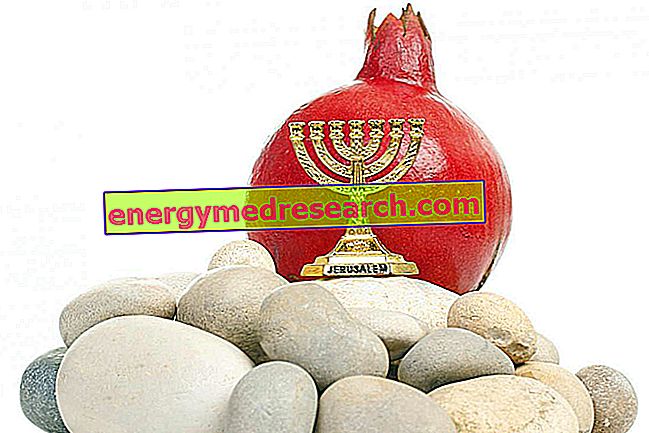Generality
What is chili pepper?
In common parlance, when we talk about chili peppers we refer to the spicy fruit produced by some plants of the genus Capsicum (Solanaceae family).

Note : the very common sweet peppers belong to the C. Annuum species.
Botanical description of the chili pepper
Of South American origin, that of chilli is a perennial sapling that reaches an average height of 100 cm. It produces green leaves and white flowers (5-7 petals), from which indehiscent seeds rich in seeds develop. In places of origin it has a perennial reproductive cycle, while in more rigid climates (as in Italy) it is annual.
Initially green, with the ripening the fruits of the chili grow, they take on a characteristic shape and can be enriched or not with carotenoids (such as capsanthin), totally changing color.
Depending on the type of pepper, the color of ripe berries can be green, red, yellow, orange, purple, brown and almost black. The size is between 2 and 10 cm or more. The shape may vary from: horn, spherical, cube etc. The aroma, flavor and spiciness also change.
Property
Nutritional characteristics of chilli
Chili is a food that falls within the VI and VII fundamental group of foods. It is a vegetable used mainly as a spice, fresh or dry. In other countries, for example in Central and South America, thanks to the habit for the spicy taste, large amounts of chilli are eaten every day.

It is cholesterol free and contains a good percentage of dietary fiber.
Ripe chili is particularly rich in vitamins; the ascorbic acid content is particularly important (229 mg of vitamin C per 100 grams of fresh fruit). The generous presence of carotenoids (precursors of vitamin A) and a fair concentration of niacin (or vitamin PP) should also be emphasized.
The contribution of mineral salts, especially potassium, is also good; less interesting but noteworthy are the levels of calcium and phosphorus.
This colorful set of nutritional principles (with the exception of vitamin C) is further concentrated in the spice pepper, then in the dried fruit and eventually reduced to powder; in the same way the spicy taste with which every day is given a little sparkling to the more dull dishes is also strengthened.
Are there dietary contraindications?
Chili does not lend itself to nutritional regimens for the treatment of esophageal, gastric and intestinal diseases. Particular attention should be paid to stomach acid, gastroesophageal reflux disease, gastritis, ulcer, irritable bowel, hemorrhoids and anal fissures.
Although in these cases it is traditionally contraindicated, some clinical studies suggest that the constant use of chili pepper can prevent some of these pathologies (in particular gastric ulcer and duodenal ulcer); on the other hand, in the acute phase it is however good practice to eliminate it from the diet.
The chili pepper has no negative repercussions in the treatment of overweight and metabolic pathologies.
The medium portion of chili pepper used as a vegetable, taking for granted the tolerance to capsaicin, is equivalent to that of sweet peppers, or 100-200 g.
| Chilli / pepper | |||
| Nutritional values per 100 g | |||
| Power | 20 kcal | ||
| Total carbohydrates | 4.64 g | ||
| Starch | - g | ||
| Simple sugars | 2.4 g | ||
| fibers | 1.7 g | ||
| Grassi | 0.17 g | ||
| Saturated | - g | ||
| Monounsaturated | - g | ||
| polyunsaturated | - g | ||
| Protein | 0.86 g | ||
| water | - g | ||
| Vitamins | |||
| Vitamin A equivalent | 18.0 μg | 2 % | |
| Beta-carotene | - μg | -% | |
| Lutein Zexanthin | - μg | ||
| Vitamin A | - IU | ||
| Thiamine or B1 | 0.057 mg | 5% | |
| Riboflavin or B2 | 0.028 mg | 2 % | |
| Niacin or PP or B3 | 0.480 mg | 3% | |
| Pantothenic acid or B5 | - mg | -% | |
| Pyridoxine or B6 | 0.224 mg | 16% | |
| folate | 10.0 μg | 3% | |
| Choline | - mg | -% | |
| Ascorbic acid or C | 80.4 μg | > 100% | |
| Vitamin D | - μg | -% | |
| Alpha-tocopherol or E | 0.37 mg | 2 % | |
| Vit. K | 7.4 μg | 7% | |
| Minerals | |||
| Football | 10.0 mg | 1% | |
| Iron | 0.34 mg | 3% | |
| Magnesium | 10.0 mg | 3% | |
| Manganese | - mg | -% | |
| Phosphorus | 20.0 mg | 3% | |
| Potassium | 175.0 mg | 3% | |
| Sodium | 3.0 mg | 3% | |
| Zinc | 0.13 mg | 2 % | |
| Fluoride | - μg | -% | |
Percentages referring to: "US recommendations" for adults.
Source: "USDA Nutrient Database"
Recipes
Chili sauce
X Problems with video playback? Reload from YouTube Go to Video Page Go to Video Recipes Section Watch the video on youtubeSee also the recipe for spicy homemade chicken wings, spicy cheese sauce, barbecue sauce and all other hot pepper recipes »
Medicinal characteristics
Properties of capsaicin
In chilli we find a substance with interesting phytotherapeutic activities; we are talking about capsaicin, the same molecule responsible for its violent and spicy taste (also present in the paprika, being derived from chilli pepper).
Capsaicin, which is concentrated in the fruit and seeds of the fruit, is known for its properties:
- Rubefacenti (if applied on the skin it induces vasodilation with transient congestion effect)
- Digestive (increases the secretion of saliva and gastric juices)
- Antioxidants
- Antibacterial.
Note : not all hypothetical effects of chilli and capsaicin have been demonstrated.
Chili and digestion
As anticipated, the chili pepper is widely used for internal use due to various digestive problems; for example in dyspepsia, dysphagia, excess of intestinal gas, diarrhea and abdominal cramps. However, these effects do not seem to have a scientifically measurable feedback.
Chili and cardiovascular system
The chili pepper, thanks to its antioxidant and capsaicin (vasodilator) content, is also used for certain cardiovascular problems, including poor circulation, high cholesterol and general heart disease prevention.
Painkiller chili pepper
For topical use, chili pepper is used in folk medicine against toothache and pain in the breast and joints.

It is possible that capsaicin is also effective against fibromyalgia and symptoms of prurigo nodularis. Taken nasally, capsaicin has a beneficial effect on certain forms of migraine.
In fact, in addition to the rubefacient effect, capsaicin also has a first painful effect (hence the characteristic burning sensation), then an analgesic; this justifies its use in ointments dedicated above all to the treatment of back pain, especially if of a muscular nature (a contracture also takes advantage of the rubefacient effect).
How capsaicin works against pain
Once applied, capsaicin induces the release of pain neurotransmitters from local terminations resulting in the typical burning sensation; after some applications, however, this sensation vanishes, as the nerves "empty" of pain neurotransmitters and lose sensitivity to the substance; this causes a reduced perception of pain. Currently the possible therapeutic applications of substances similar to capsaicin but with less irritating effect are being investigated.
Decongestant Capsaicin
Capsaicin alleviates the symptoms of chronic rhinitis, especially not associated with allergies or infections, when used nasally.
Sometimes the benefits can last up to 6-9 months after treatment.
Capsaicin for hair
In addition to those already reported we recall the possible usefulness of the substance against hair loss (not only for traditional external use, but above all for internal use).
Curiosity: How to alleviate the hotness of chilli?
Since capsaicin is a fat-soluble substance, to combat burning on the palate resulting from excessive ingestion of chili peppers, it is a good rule to drink yogurt or whole milk, or chew a piece of cheese or bread with oil.
Fresh water gives an initial sense of relief that vanishes after only a moment; on balance, no use.
Side effects
Side effects of chilli and capsaicin
Applied on the skin, lotions and medicinal creams containing chilli extract are probably considered safe for most adults.
The side effects of chili can include: skin irritation, burning and itching. Capsaicin can also be extremely irritating to the eyes, nose and throat.
Taken by mouth, in the short term and in quantities typically found in foods, pepper extract is probably safe for most adults. Side effects can include stomach irritation, sweating and a runny nose.
In rare cases, taking large quantities and for long periods of pepper can lead to serious side effects, such as damage to the liver or kidney.
Chili extract is probably safe also nasally. No serious side effects have been reported, but the application can be very painful and cause: burning, sneezing, watery eyes and a runny nose. These effects tend to decrease and disappear after 5 or more days of repeated use.
Caution is advised during pregnancy and lactation. When mothers routinely consume foods heavily spiced with chili peppers, mild dermatitis may appear on the infant.
Avoid administration in children and on damaged skin.
Stop taking capsaicin-based products at least 2 weeks before surgery.
Interactions
Pharmacological interactions of chilli and capsaicin
The interaction between capsaicin and cocaine is known; chili pepper seems to increase the side effects of the amazing drug.
In addition, chilli may reduce blood clotting and are not recommended to be combined with drugs that have the same effect as: aspirin, clopidogrel, diclofenac, ibuprofen, naproxen, dalteparin, enoxaparin, heparin, warfarin etc.
Capsaicin can increase the cough caused by antihypertensive drugs.



